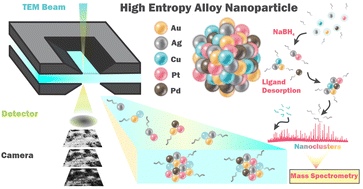Visualizing formation of high entropy alloy nanoparticles with liquid phase transmission electron microscopy†
Abstract
High entropy alloy (HEA) nanoparticles hold promise as active and durable (electro)catalysts. Understanding their formation mechanism will enable rational control over composition and atomic arrangement of multimetallic catalytic surface sites to maximize their activity. While prior reports have attributed HEA nanoparticle formation to nucleation and growth, there is a dearth of detailed mechanistic investigations. Here we utilize liquid phase transmission electron microscopy (LPTEM), systematic synthesis, and mass spectrometry (MS) to demonstrate that HEA nanoparticles form by aggregation of metal cluster intermediates. AuAgCuPtPd HEA nanoparticles are synthesized by aqueous co-reduction of metal salts with sodium borohydride in the presence of thiolated polymer ligands. Varying the metal : ligand ratio during synthesis showed that alloyed HEA nanoparticles formed only above a threshold ligand concentration. Interestingly, stable single metal atoms and sub-nanometer clusters are observed by TEM and MS in the final HEA nanoparticle solution, suggesting nucleation and growth is not the dominant mechanism. Increasing supersaturation ratio increased particle size, which together with observations of stable single metal atoms and clusters, supported an aggregative growth mechanism. Direct real-time observation with LPTEM imaging showed aggregation of HEA nanoparticles during synthesis. Quantitative analyses of the nanoparticle growth kinetics and particle size distribution from LPTEM movies were consistent with a theoretical model for aggregative growth. Taken together, these results are consistent with a reaction mechanism involving rapid reduction of metal ions into sub-nanometer clusters followed by cluster aggregation driven by borohydride ion induced thiol ligand desorption. This work demonstrates the importance of cluster species as potential synthetic handles for rational control over HEA nanoparticle atomic structure.



 Please wait while we load your content...
Please wait while we load your content...